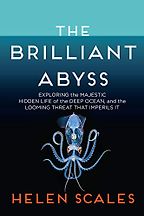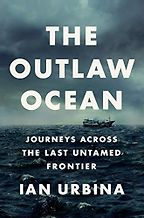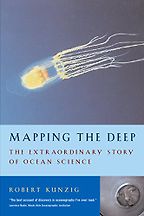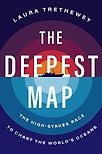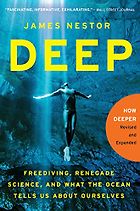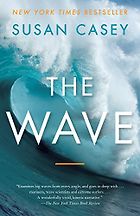You’re an environmental and ocean journalist and the author of two books about how humans engage with the seas. Can you tell us a little bit about the magic of the ocean?
I have been writing about the oceans for a while now. My first book, The Imperiled Ocean, portrays the ocean from various perspectives, through the stories of refugees, artists, and scientists. While writing it, I realized I like writing about ocean science. In that book I wrote about the biologist Erin Stoddard who works with white sturgeon, an incredible dinosaur-like fish that can inhabit both rivers and oceans. It is just the coolest thing for marine scientists that a fish can breathe in saltwater and in freshwater.
This sparked my interest in ocean science. I worked at an aquarium in Vancouver, BC, for a few years. I was writing about all kinds of cool marine animals and ocean currents. Along the way I started to write about ocean mapping, and that’s what my new book is about. I honed in on this tiny, niche subculture of ocean science.
A couple of years ago, I decided to call myself an ocean journalist. The reaction was, ‘That sounds like such a cool job. What’s an ocean journalist?’ No one had ever heard of it before. I made it up because I realized I like to write about the ocean. It’s a vast field that is undercovered when it comes to journalism.
I thought, ‘That’s my beat. It’s 71 percent of the planet, and I’m just going to tackle that.’ That seems like more than enough work for the rest of my life.
There is a small community, which includes a few of the writers that I will mention in this interview: Susan Casey, Ian Urbina, and Helen Scales. It’s a small but burgeoning group of writers who have decided to focus on this overlooked part of the planet.
Amazing. Your first recommendation for us is The Brilliant Abyss by Helen Scales. Can you introduce us to this book?
This book is wonderful. As you can see, I’ve read it very thoroughly—there are a million Post-it notes all through it. Helen Scales is a trained marine biologist, writer, and public broadcaster. She is an extraordinary writer who can unpack very complex ocean science and make it fascinating and digestible for the average person.
The Brilliant Abyss is a deep dive into the extraordinary life and the seafloor features that we’re finding in the deep sea and all the potential discoveries that accompany them. At the same time, it’s about the growing threats to the deep sea, including deep sea fishing and deep sea mining. These forces are converging on the deep sea, which is the world’s largest wilderness refuge in the world. It makes sense that all these industrial forces want to extract from and exploit it.
Scales writes about the beauty of the deep sea and the threats to it.
People talk about living at a time where everything’s already been discovered, but how true is that for the deep sea? Is it still a new frontier?
It’s definitely a new frontier. We’ve mapped only about 25 percent of the seafloor. The Moon and Mars have been completely mapped, but we don’t have a base map for our planet yet. That seems crazy.
While writing my book, I kept track of all the extraordinary discoveries taking place during those few years. New islands popped out of the sea, due to shifting tectonic plates. In the depths of the ocean, new animals were discovered, and animals were witnessed swimming in deeper waters where they had never been seen before.
New things are coming out all the time. It’s one of those rare scientific fields where you can still make basic discoveries—mind-blowing discoveries—and they even happen accidentally.
And why is there still so much to do?
The ocean is a hard place to work. It’s so vast and so deep. It covers 71 percent of the planet. On average, it’s two and a half miles deep, so you have to travel a long way down to study animals on the seafloor. It’s a hostile work environment, due to the wind and the waves. And it’s incredibly expensive to work out there. All these factors contribute to making it a more difficult place to study.
At the same time, we have some ocean blindness around this frontier. Because it’s out of sight, it’s out of mind. We see only the ocean’s surface; we’re not predisposed to explore beneath it. It’s naturally elusive and mysterious.
That makes a lot of sense. Your next recommendation for us is The Outlaw Ocean by Ian Urbina. Could you tell us a little bit about this book?
This book came out at around the same time as my first book, The Imperiled Ocean. They’re similar in some ways, but I would say Urbina’s book is much better than mine.
Each chapter investigates a specific sector of the clandestine operations that take place out at sea. He delves into the many weird corners of this world, including illegal fishing, the oil and gas industry, pirates, smuggling, and human trafficking.
Urbina must be an adrenaline junkie. He takes you to some dangerous and terrifying places. It’s an exceptional piece of literary journalism and reporting. There is no other book out there like this. Every single chapter is fantastic.
Is there a special connection between the ocean and outlaws?
Yes. The ‘out of sight, out of mind’ ocean blindness that I talked about makes the ocean a place that is prone to crime. More crime happens out there and less of it gets reported. It’s an ideal place for traffickers to move products and people and where refugees and migrants can slip past borders.
This book contains a chapter about an activist in Mexico, where abortion was only recently decriminalized, who provides abortions out at sea. This is an example of how you can sidestep the laws that apply on land in order to help people. The ocean is a place that facilitates good and bad—though mostly bad—illegal activities.
There are so many examples. One thing that shocked me recently was a story in The Brilliant Abyss about the industry of shipping cattle from country to country. I’ve never heard of this before. It made no sense to me. You would think we would consume the cow where it had been raised. Apparently, it’s cheaper to raise cattle in a particular region and then ship it across the sea to another region.
This adds to the carbon emissions caused by eating beef, and there are horrific stories of cattle ships sinking out at sea. If you are vegetarian or vegan, this will make you even more certain that you’re doing the right thing.
Moving on, your next ocean journalism recommendation for us is Mapping the Deep by Robert Kunzig. Can you tell us a little bit about this book?
Of the five books that I chose, this is definitely the most scientific one. It’s written by Robert Kunzig, a former National Geographic writer, and it’s beautifully done. It’s about twenty years old, but it stands the test of time.
Kunzig chronicles major discoveries in various areas of ocean science. There’s an excellent chapter on early attempts to map the ocean floor by satellite. In the Eighties, William Haxby, a scientist at Lamont-Doherty Earth Observatory in upstate New York, came up with a method to read the surface and the gravity of the ocean. From that, he was able to determine the general shape of the seafloor. This was a huge step forward in ocean mapping.
Since then, researchers have made a lot of progress. Back when William Haxby was doing this, the resolution of ocean maps was not very good resolution, maybe over 20 kilometers or higher,. Today, we’re able to make maps that are about 4 kilometers in resolution. It’s an evolving science. To date, the most complete maps we have of the ocean floor are made by satellites, not by ocean mappers out at sea on ships.
Kunzig’s book also contains wonderful writing on fascinating deep sea organisms that we’re still figuring out today. It’s a great primer on the various areas that are being researched in ocean science and provides a solid grounding on what scientists are exploring and the questions they’re asking about the ocean.
This seems like a great time to mention your own new book, The Deepest Map. Can you tell us about your book and what’s going on right now in ocean mapping? It sounds like it’s an exciting time.
My book is about Seabed 2030, which is a new initiative to map the ocean by the end of this decade. The project started in 2017 when about 15 percent of the seafloor was mapped. Over the last six years it has brought that coverage up to 25 percent. It has made considerable progress, mainly by asking countries to share the ocean maps that are in their secret vaults, but it is still nowhere close to mapping the entire seafloor.
My book also follows Cassie Bongiovanni—an ocean mapper who’s contributing to the Seabed 2030 project—on a private expedition with Victor Vascovo, a private equity investor turned ocean explorer. Vascovo wanted to dive the deepest points of all five oceans but no one knew where those points were, so he brought Bongiovanni on board to make the first maps of the deepest points.
The book follows Cassie’s adventures and her maps into Seabed 2030 and we find out what happens to them, and then the book branches out from there to examine various aspects of how we’re discovering the deep sea.
How complex is the geopolitics of ocean mapping? Is this quite a controversial field?
Yes. I hinted at the fact that there are secret map vaults. The geopolitics involved are very complicated. Currently, Seabed 2030 is trying to concentrate a lot of its efforts on the international sea floor (which constitutes about 50 percent of the ocean) because much of this territory has not yet been mapped, and as you move closer to shore, everything becomes more complicated.
Many countries consider mapping within their waters to be spying, essentially. In some cases, they might be right. There are many questions about why people are making those maps and what they’re going to do with them. There are a lot of conspiracy theories floating around in this world. However, Seabed 2030 is a scientific effort. It was undertaken so that we might better understand the ocean and form a more complete outline of our planet – one that we’ve never had before.
I’ll have to read the book. Your next recommendation for us is the ocean science book Deep, by James Nestor. Could you introduce us to this work?
This book also has a million Post-it notes on it. Deep explores the ocean from its surface to its depths via the extreme sport of freediving, where divers descend as deep into the ocean as they can on a single breath.
Nestor frames a freediver’s descent into the ocean through a closeup of the human body and what happens to it, in terms of the pressure on the body and the oxygen supply, and uncovers some stunning revelations. It’s an intimate, human look at diving. Nestor also looks beyond freediving into many other areas, including what can be found on the seafloor and why that matters to humanity.
Nestor has recently published a book called Breath, which is a detailed portrait about what happens when we breathe. You can see how writing the freediving book may have inspired his next book.
Is there any consensus on how evolutionarily adapted we are to being in the ocean? I know I always feel very at home in the sea, but I don’t know if that applies to everyone.
Earlier in the last century, there was this aquatic ape theory that modern humans descended from an ape that was more adapted to the ocean. It was suggested that this is why we’re mostly hairless like whales, why we have this diving reflex to hold our breath from a young age.
Now we know that this theory is not correct. We do know that life started in water, that the first organisms appeared in the deep sea, likely at hydrothermal vents, where the first chemical sparks of life caught fire. That life evolved first in the ocean and then eventually crawled out of the seas and then long after that humans appeared.
Still, we have a lot of deep ties to the water. Our bodies are mostly water. The womb contains fluid that’s very similar to seawater, and a lot of our features in the early stages of development appear somewhat fish-like. Every other breath we take depends on the ocean—it’s oxygen produced by the ocean. James Nestor’s book looks into all the ways in which we’re linked to the ocean.
Your last recommendation for us is The Wave by Susan Casey. Can you tell us a little about this book?
Susan Casey is a seasoned chronicler of the ocean and someone I look up to enormously. She’s written books about dolphin communication, the Farallon Islands and diving with sharks, and then there’s The Wave, which takes place in Hawaii, where Casey lived at the time, and she follows around legendary surfer Laird Hamilton as he attempts to surf a 100-foot-wave – something that’s never been done before. She also does her background research, providing a lot of science on currents, wave formation and the changing ocean, as well as first-hand accounts from ship captains and insurance companies about monster waves that will scare most landlubbers into never taking a cruise again.
I’m also looking forward to Susan Casey’s new book, The Underworld, which came out earlier this month. It’s all about the deep sea and I know that she was on some of the same expeditions that I cover in my book. I’m so excited to read it.
Interview by Uri Bram
August 25, 2023. Updated: August 27, 2023
Five Books aims to keep its book recommendations and interviews up to date. If you are the interviewee and would like to update your choice of books (or even just what you say about them) please email us at [email protected]
Five Books interviews are expensive to produce. If you've enjoyed this interview, please support us by donating a small amount.
